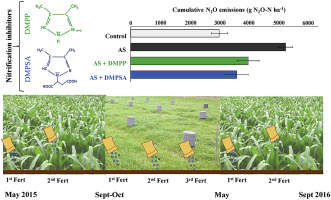当前位置:
X-MOL 学术
›
Atmos. Environ.
›
论文详情
Our official English website, www.x-mol.net, welcomes your feedback! (Note: you will need to create a separate account there.)
DMPSA and DMPP equally reduce N 2 O emissions from a maize-ryegrass forage rotation under Atlantic climate conditions
Atmospheric Environment ( IF 5 ) Pub Date : 2018-08-01 , DOI: 10.1016/j.atmosenv.2018.05.065 Ximena Huérfano , José María Estavillo , Teresa Fuertes-Mendizábal , Fernando Torralbo , Carmen González-Murua , Sergio Menéndez
Atmospheric Environment ( IF 5 ) Pub Date : 2018-08-01 , DOI: 10.1016/j.atmosenv.2018.05.065 Ximena Huérfano , José María Estavillo , Teresa Fuertes-Mendizábal , Fernando Torralbo , Carmen González-Murua , Sergio Menéndez

|
Abstract The increase of the global demand for dairy products is reflected in a rise of animal feed and forage productivity. In the coastal Atlantic climate conditions of northern Spain the maize-ryegrass rotation is a common management used to satisfy this forage demand. With the aim of mitigating greenhouse gases (GHG) emissions associated with fertilization in this type of intensive management, the use of nitrification inhibitors (NI) such as 3,4-dimethylpyrazol phosphate (DMPP) or the isomeric mixture of 2-(3,4-dimethyl-1H-pyrazol-1-yl) succinic acid and 2-(4,5-dimethyl-1H-pyrazol-1-yl) succinic acid (DMPSA) could be a useful strategy. Until now, the new NI DMPSA has only been evaluated under Mediterranean conditions. The objective of this study was to compare the efficiency of DMPSA with respect to DMPP reducing GHG emissions when applied in a maize-ryegrass rotation under Atlantic climate conditions. Nitrogen fertilizer was applied as ammonium sulphate, with and without both NIs, split into two applications of 80 and 100 kg N ha−1 in the case of maize and in three applications of 80, 60 and 60 kg N ha−1 in the case of ryegrass. An unfertilized control treatment was also included. Nitrous oxide (N2O) and methane (CH4) fluxes were measured using the closed chamber technique. The new NI DMPSA showed a similar behaviour to DMPP, mitigating N2O emissions down to the levels of the unfertilized soil. The effect of DMPSA reducing N2O losses lasted for the same time as for DMPP (l
中文翻译:

DMPSA 和 DMPP 同样减少了大西洋气候条件下玉米-黑麦草轮作的 N 2 O 排放
摘要 全球对乳制品需求的增加反映在动物饲料和草料生产力的提高上。在西班牙北部沿海大西洋气候条件下,玉米-黑麦草轮作是一种常见的管理方式,用于满足这种牧草需求。为了减少此类集约化管理中与施肥相关的温室气体 (GHG) 排放,使用硝化抑制剂 (NI),例如 3,4-二甲基吡唑磷酸盐 (DMPP) 或 2-(3, 4-二甲基-1H-吡唑-1-基)琥珀酸和2-(4,5-二甲基-1H-吡唑-1-基)琥珀酸(DMPSA)可能是一种有用的策略。到目前为止,新的 NI DMPSA 仅在地中海条件下进行了评估。本研究的目的是比较 DMPSA 与 DMPP 在大西洋气候条件下应用于玉米-黑麦草轮作时减少温室气体排放的效率。氮肥以硫酸铵的形式施用,有和没有两种 NI,在玉米的情况下分为 80 和 100 kg N ha-1 两次施用,在这种情况下分为 80、60 和 60 kg N ha-1 两次施用黑麦草。还包括未受精的对照处理。使用密闭室技术测量一氧化二氮 (N2O) 和甲烷 (CH4) 通量。新的 NI DMPSA 表现出与 DMPP 类似的行为,将 N2O 排放量降低到未施肥土壤的水平。DMPSA 减少 N2O 损失的效果与 DMPP 的持续时间相同 (l 氮肥以硫酸铵的形式施用,有和没有两种 NI,在玉米的情况下分为 80 和 100 kg N ha-1 两次施用,在这种情况下分为 80、60 和 60 kg N ha-1 两次施用黑麦草。还包括未受精的对照处理。使用密闭室技术测量一氧化二氮 (N2O) 和甲烷 (CH4) 通量。新的 NI DMPSA 表现出与 DMPP 类似的行为,将 N2O 排放量降低到未施肥土壤的水平。DMPSA 减少 N2O 损失的效果与 DMPP 的持续时间相同 (l 氮肥以硫酸铵的形式施用,有和没有两种 NI,在玉米的情况下分为 80 和 100 kg N ha-1 两次施用,在这种情况下分为 80、60 和 60 kg N ha-1 两次施用黑麦草。还包括未受精的对照处理。使用密闭室技术测量一氧化二氮 (N2O) 和甲烷 (CH4) 通量。新的 NI DMPSA 表现出与 DMPP 类似的行为,将 N2O 排放量降低到未施肥土壤的水平。DMPSA 减少 N2O 损失的效果与 DMPP 的持续时间相同 (l 使用密闭室技术测量一氧化二氮 (N2O) 和甲烷 (CH4) 通量。新的 NI DMPSA 表现出与 DMPP 类似的行为,将 N2O 排放量降低到未施肥土壤的水平。DMPSA 减少 N2O 损失的效果与 DMPP 的持续时间相同 (l 使用密闭室技术测量一氧化二氮 (N2O) 和甲烷 (CH4) 通量。新的 NI DMPSA 表现出与 DMPP 类似的行为,将 N2O 排放量降低到未施肥土壤的水平。DMPSA 减少 N2O 损失的效果与 DMPP 的持续时间相同 (l
更新日期:2018-08-01
中文翻译:

DMPSA 和 DMPP 同样减少了大西洋气候条件下玉米-黑麦草轮作的 N 2 O 排放
摘要 全球对乳制品需求的增加反映在动物饲料和草料生产力的提高上。在西班牙北部沿海大西洋气候条件下,玉米-黑麦草轮作是一种常见的管理方式,用于满足这种牧草需求。为了减少此类集约化管理中与施肥相关的温室气体 (GHG) 排放,使用硝化抑制剂 (NI),例如 3,4-二甲基吡唑磷酸盐 (DMPP) 或 2-(3, 4-二甲基-1H-吡唑-1-基)琥珀酸和2-(4,5-二甲基-1H-吡唑-1-基)琥珀酸(DMPSA)可能是一种有用的策略。到目前为止,新的 NI DMPSA 仅在地中海条件下进行了评估。本研究的目的是比较 DMPSA 与 DMPP 在大西洋气候条件下应用于玉米-黑麦草轮作时减少温室气体排放的效率。氮肥以硫酸铵的形式施用,有和没有两种 NI,在玉米的情况下分为 80 和 100 kg N ha-1 两次施用,在这种情况下分为 80、60 和 60 kg N ha-1 两次施用黑麦草。还包括未受精的对照处理。使用密闭室技术测量一氧化二氮 (N2O) 和甲烷 (CH4) 通量。新的 NI DMPSA 表现出与 DMPP 类似的行为,将 N2O 排放量降低到未施肥土壤的水平。DMPSA 减少 N2O 损失的效果与 DMPP 的持续时间相同 (l 氮肥以硫酸铵的形式施用,有和没有两种 NI,在玉米的情况下分为 80 和 100 kg N ha-1 两次施用,在这种情况下分为 80、60 和 60 kg N ha-1 两次施用黑麦草。还包括未受精的对照处理。使用密闭室技术测量一氧化二氮 (N2O) 和甲烷 (CH4) 通量。新的 NI DMPSA 表现出与 DMPP 类似的行为,将 N2O 排放量降低到未施肥土壤的水平。DMPSA 减少 N2O 损失的效果与 DMPP 的持续时间相同 (l 氮肥以硫酸铵的形式施用,有和没有两种 NI,在玉米的情况下分为 80 和 100 kg N ha-1 两次施用,在这种情况下分为 80、60 和 60 kg N ha-1 两次施用黑麦草。还包括未受精的对照处理。使用密闭室技术测量一氧化二氮 (N2O) 和甲烷 (CH4) 通量。新的 NI DMPSA 表现出与 DMPP 类似的行为,将 N2O 排放量降低到未施肥土壤的水平。DMPSA 减少 N2O 损失的效果与 DMPP 的持续时间相同 (l 使用密闭室技术测量一氧化二氮 (N2O) 和甲烷 (CH4) 通量。新的 NI DMPSA 表现出与 DMPP 类似的行为,将 N2O 排放量降低到未施肥土壤的水平。DMPSA 减少 N2O 损失的效果与 DMPP 的持续时间相同 (l 使用密闭室技术测量一氧化二氮 (N2O) 和甲烷 (CH4) 通量。新的 NI DMPSA 表现出与 DMPP 类似的行为,将 N2O 排放量降低到未施肥土壤的水平。DMPSA 减少 N2O 损失的效果与 DMPP 的持续时间相同 (l

























 京公网安备 11010802027423号
京公网安备 11010802027423号